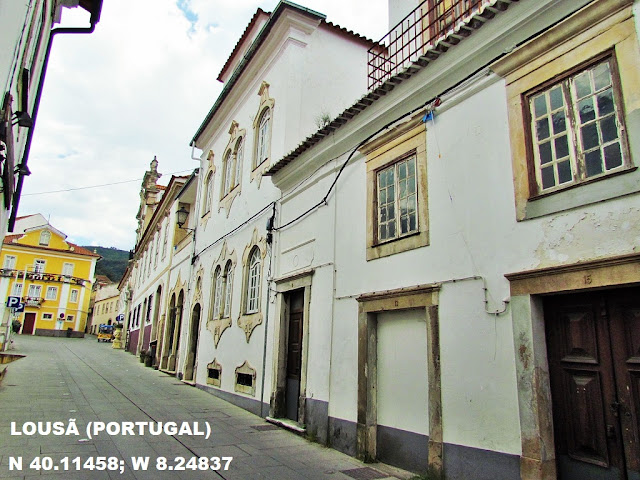LOUSÃ
N 40.11458; W 8.24837
Lousã is a municipality in the district of Coimbra, in the central part of Portugal. The population in 2011 was 17,604, in an area of 138.40 km2.
Located in the central part of Portugal, the municipality of Lousa, is part of the old district of Coimbra, in the subregion of Pinhal Interior Norte, and limited in the north by Vila Nova de Poiares, in the east by Góis and Miranda do Corvo, and in the south by Castanheira de Pêra and Figueiró dos Vinhos, making part of the district of Leiria.
Many of its residents commute to the city of Coimbra for work, shopping or attend schools, including the Coimbra University or the hospital.
💗💗💗
LOUSÃ CASTLE
40°06′03″N; 8°14′08″W
The Castle of Lousã (Portuguese: Castelo da Lousã), also known as the Castle of Arouce (Portuguese: Castelo de Arouce), is situated 2 kilometres (1.2 mi) from the civil parish of Lousã e Vilarinho, municipality of Lousã. It was constructed in the second-half of the 11th century, on the right margin of the River Arouce.
History
In 1080, count Sisnando Davides occupied the settlement of Lousã peacefully (but was later reoccupied by the Moors). The castle was part of the first defensive lines constructed to protect the access-ways to Coimbra, during the count's stewardship, during the second-half of the 11th century. The smaller perimeter of the military structure corresponded to this early period, with later expansions associated with the early middle ages.
It was in 1124, when the Moorish garrison fell and the castle was re-occupied by the forces of D. Teresa, who completed reparation of the defenses. Eventually, the royal court of Queen D. Mafalda would spend her summers in the settlement and castle.
During the early years of the Portuguese monarchy, the region occupied an important position owing to its frontier status. In 1124, Moorish incursions were responsible for taking the castle. In 1151, a foral was issued by D. Afonso Henriques, owing to its military importance: during the 12th century, there were several raids by Moors across the valley of Zêzere. By that time, Lousã was no longer a frontier town, owing to the conquest of Santarém, Lisbon and Palmela in 1147. During this time, the kingdom had a policy of settlement that attempted to fix and stabilize the Portuguese population centers and promote further occupation of the land.
The keep tower was constructed during the 14th Century.
A new foral was issued in 1513 by King D. Manuel. As its military role ceased to be important, the castle fell into disuse.
Until 1759, the signeurial rights to the region were maintained by the Dukes of Aveiro, but were transferred back to the Crown.
Rights to the castle and land were ceded to the municipality on 10 August 1957; on 27 April 2019, the re-qualified castle was inaugurated, later to include a newly constructed viewpoint and visitors' center.
Architecture
The small castle with irregular, hexagonal plan encircles a small courtyard. It is dominated in the north by a keep tower, that is addorsed to the wall, consisting of a rectangular structure with ogival doorway at the level of the chemin de ronde covered in arrowslits. Chamfered merlons terminate the supper part of the structure.
The main entrance is located in the southeast corner and is protected by two semi-cylindrical corbels. An elongated corbel is located to the southwest, while two smaller corbels are situated in the west of the castle, that complete the defensive structures along the walls that are completed with chamfered merlons, similar to those in the keep tower.

💗💗💗
Senhora da Piedade Walkways
40°6′52.92″N; 8°14′38.0″W
The walkway is part of a route, consisting of 1.2 kilometers, with the main highlight being “a panoramic wooden walkway, which makes it possible to travel on foot, safely, between the town of Lousã, the Castle and the Swimming Pools, which didn’t happen before”, says Centro Turismo. The natural pools of Nossa Senhora da Piedade and Baloiço do Burgo, which is over water, are a major tourist attraction in Lousã, and with this path they are now lit up at night, to facilitate access.
This new structure takes you to Praia Fluvial da Senhora da Piedade, a scene of incredible natural beauty. Shale is a permanent presence on this beach, and the diving board, measuring approximately 1.75 meters, is also made of this material. The beach is made up of two natural pools, with a shallower pool for kids to cool off and play to their heart's content. There is also a café with a terrace and solarium area.
The natural and landscape complex of Senhora da Piedade is located next to a river, with the castle of Arouce on the other bank of the river. The intervention in this space represented an investment of “around 400 thousand euros”, according to information from Lousã city council, cited by “Público”. The renovation “included the construction of the pedestrian path” and “several interventions in this area”. This region is part of a municipality where there are five Schist Villages.


































































